NCERT Solutions for Class 10 Maths Chapter 8 Introduction to Trigonometry
Introduction to Trigonometry Solutions – Class 10 Maths
Exercise 8.1 : Solutions of Questions on Page Number : 181
Q1 : In ΔABC right angled at B, AB = 24 cm, BC = 7 m. Determine
(i) sin A, cos A
(ii) sin C, cos C
Answer :
Applying Pythagoras theorem for ΔABC, we obtain
AC2 = AB2 + BC2
= (24 cm)2 + (7 cm)2
= (576 + 49) cm2
= 625 cm2
∴ AC =![]() cm = 25 cm
cm = 25 cm
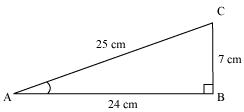
(i) sin A =![]()
![]()
cos A =![]()
(ii)

sin C =![]()
![]()
cos C =![]()
![]()
Q2 : In the given figure find tan P – cot R

Answer :
Applying Pythagoras theorem for ΔPQR, we obtain
PR2 = PQ2 + QR2
(13 cm)2 = (12 cm)2 + QR2
169 cm2 = 144 cm2 + QR2
25 cm2 = QR2
QR = 5 cm
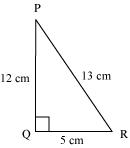

tan P – cot R =![]()
Q3 : If sin A =![]() , calculate cos A and tan A.
, calculate cos A and tan A.
Answer :
Let ΔABC be a right-angled triangle, right-angled at point B.
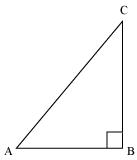
Given that,

Let BC be 3k. Therefore, AC will be 4k, where k is a positive integer.
Applying Pythagoras theorem in ΔABC, we obtain
AC2 = AB2 + BC2
(4k)2 = AB2 + (3k)2
16k2 – 9k2 = AB2
7k2 = AB2
AB =![]()
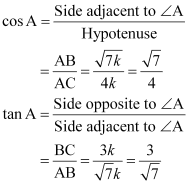
Q4 : Given 15 cot A = 8. Find sin A and sec A
Answer :
Consider a right-angled triangle, right-angled at B.
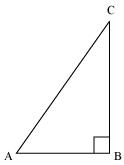

It is given that,
cot A =![]()
![]()
Let AB be 8k.Therefore, BC will be 15k, where k is a positive integer.
Applying Pythagoras theorem in ΔABC, we obtain
AC2 = AB2 + BC2
= (8k)2 + (15k)2
= 64k2 + 225k2
= 289k2
AC = 17k

Q5 : Given sec θ =![]() , calculate all other trigonometric ratios.
, calculate all other trigonometric ratios.
Answer :
Consider a right-angle triangle ΔABC, right-angled at point B.


If AC is 13k, AB will be 12k, where k is a positive integer.
Applying Pythagoras theorem in ΔABC, we obtain
(AC)2 = (AB)2 + (BC)2
(13k)2 = (12k)2 + (BC)2
169k2 = 144k2 + BC2
25k2 = BC2
BC = 5k
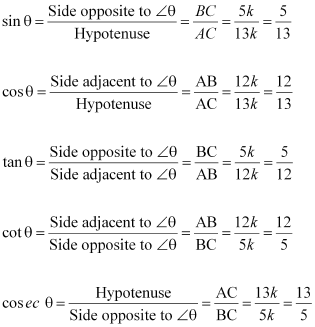
Q6 : If ∠ A and ∠ B are acute angles such that cos A = cos B, then show that
∠ A = ∠ B.
Answer :
Let us consider a triangle ABC in which CD ⊥ AB.

It is given that
cos A = cos B
![]() … (1)
… (1)
We have to prove ∠A = ∠B. To prove this, let us extend AC to P such that BC = CP.

From equation (1), we obtain

By using the converse of B.P.T,
CD||BP
⇒∠ACD = ∠CPB (Corresponding angles) … (3)
And, ∠BCD = ∠CBP (Alternate interior angles) … (4)
By construction, we have BC = CP.
∴ ∠CBP = ∠CPB (Angle opposite to equal sides of a triangle) … (5)
From equations (3), (4), and (5), we obtain
∠ACD = ∠BCD … (6)
In ΔCAD and ΔCBD,
∠ACD = ∠BCD [Using equation (6)]
∠CDA = ∠CDB [Both 90°]
Therefore, the remaining angles should be equal.
∴∠CAD = ∠CBD
⇒ ∠A = ∠B
Alternatively,
Let us consider a triangle ABC in which CD ⊥ AB.

It is given that,
cos A = cos B

Let![]()
⇒ AD = k BD … (1)
And, AC = k BC … (2)
Using Pythagoras theorem for triangles CAD and CBD, we obtain
CD2 = AC2 – AD2 … (3)
And, CD2 = BC2 – BD2 … (4)
From equations (3) and (4), we obtain
AC2 – AD2 = BC2 – BD2
⇒ (k BC)2 – (k BD)2 = BC2 – BD2
⇒ k2 (BC2 – BD2) = BC2 – BD2
⇒ k2 = 1
⇒ k = 1
Putting this value in equation (2), we obtain
AC = BC
⇒ ∠A = ∠B(Angles opposite to equal sides of a triangle)
Q7 : If cot θ =![]() , evaluate
, evaluate
(i) ![]() (ii) cot2 θ
(ii) cot2 θ
Answer :
Let us consider a right triangle ABC, right-angled at point B.


If BC is 7k, then AB will be 8k, where k is a positive integer.
Applying Pythagoras theorem in ΔABC, we obtain
AC2 = AB2 + BC2
= (8k)2 + (7k)2
= 64k2 + 49k2
= 113k2
AC =![]()
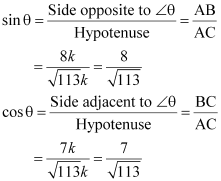
(i)


(ii) cot2 θ = (cot θ)2 = ![]() =
=![]()
Q8 : If 3 cot A = 4, Check whether![]()
Answer :
It is given that 3cot A = 4
Or, cot A =![]()
Consider a right triangle ABC, right-angled at point B.


If AB is 4k, then BC will be 3k, where k is a positive integer.
In ΔABC,
(AC)2 = (AB)2 + (BC)2
= (4k)2 + (3k)2
= 16k2 + 9k2
= 25k2
AC = 5k
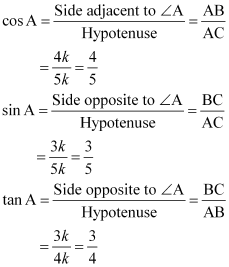
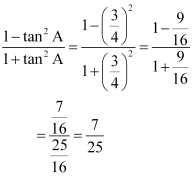
cos2 A – sin2 A =![]()
![]()
∴![]()
Q9 : In ΔABC, right angled at B. If![]() , find the value of
, find the value of
(i) sin A cos C + cos A sin C
(ii) cos A cos C – sin A sin C
Answer :
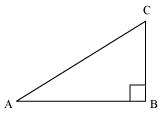

If BC is k, then AB will be![]() , where k is a positive integer.
, where k is a positive integer.
In ΔABC,
AC2 = AB2 + BC2
=![]()
= 3k2 + k2 = 4k2
∴ AC = 2k
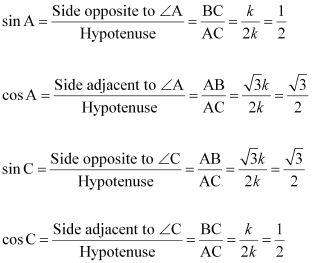
(i) sin A cos C + cos A sin C

(ii) cos A cos C – sin A sin C

Q10 : In ΔPQR, right angled at Q, PR + QR = 25 cm and PQ = 5 cm. Determine the values of sin P, cos P and tan P.
Answer :
Given that, PR + QR = 25
PQ = 5
Let PR be x.
Therefore, QR = 25 – x
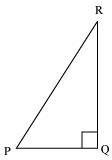
Applying Pythagoras theorem in ΔPQR, we obtain
PR2 = PQ2 + QR2
x2 = (5)2 + (25 – x)2
x2 = 25 + 625 + x2 – 50x
50x = 650
x = 13
Therefore, PR = 13 cm
QR = (25 – 13) cm = 12 cm

Q11 : State whether the following are true or false. Justify your answer.
(i) The value of tan A is always less than 1.
(ii) sec A =![]() for some value of angle A.
for some value of angle A.
(iii) cos A is the abbreviation used for the cosecant of angle A.
(iv) cot A is the product of cot and A
(v) sin θ =![]() , for some angle θ
, for some angle θ
Answer :
(i) Consider a ΔABC, right-angled at B.
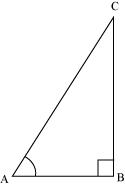

But > 1
∴tan A > 1
So, tan A < 1 is not always true.
Hence, the given statement is false.
(ii)![]()
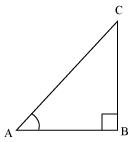

Let AC be 12k, AB will be 5k, where k is a positive integer.
Applying Pythagoras theorem in ΔABC, we obtain
AC2 = AB2 + BC2
(12k)2 = (5k)2 + BC2
144k2 = 25k2 + BC2
BC2 = 119k2
BC = 10.9k
It can be observed that for given two sides AC = 12k and AB = 5k,
BC should be such that,
AC – AB < BC < AC + AB
12k – 5k < BC < 12k + 5k
7k < BC < 17 k
However, BC = 10.9k. Clearly, such a triangle is possible and hence, such value of sec A is possible.
Hence, the given statement is true.
(iii) Abbreviation used for cosecant of angle A is cosec A. And cos A is the abbreviation used for cosine of angle A.
Hence, the given statement is false.
(iv) cot A is not the product of cot and A. It is the cotangent of ∠A.
Hence, the given statement is false.
(v) sin θ =![]() We know that in a right-angled triangle,
We know that in a right-angled triangle,
![]() In a right-angled triangle, hypotenuse is always greater than the remaining two sides. Therefore, such value of sin θ is not possible.
In a right-angled triangle, hypotenuse is always greater than the remaining two sides. Therefore, such value of sin θ is not possible.
Hence, the given statement is false
Exercise 8.2 : Solutions of Questions on Page Number : 187
Q1 : Evaluate the following
(i) sin60° cos30° + sin30° cos60°
(ii) 2tan245° + cos230° – sin260°
(iii)![]()
(iv)![]()
(v)![]()
Answer :
(i) sin60° cos30° + sin30° cos60°

(ii) 2tan245° + cos230° – sin260°

(iii)![]()

(iv)![]()
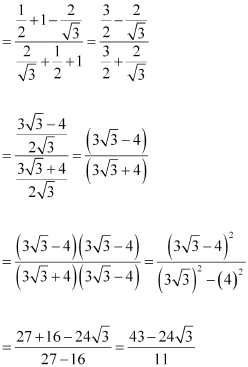
(v)![]()
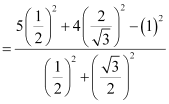
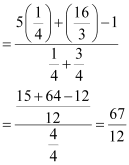
Q2 : Choose the correct option and justify your choice.
(i)![]()
(A). sin60°
(B). cos60°
(C). tan60°
(D). sin30°
(ii)![]()
(A). tan90°
(B). 1
(C). sin45°
(D). 0
(iii) sin2A = 2sinA is true when A =
(A). 0°
(B). 30°
(C). 45°
(D). 60°
(iv)![]()
(A). cos60°
(B). sin60°
(C). tan60°
(D). sin30°
Answer :
(i)![]()
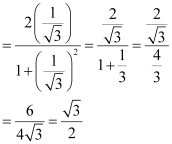
Out of the given alternatives, only![]()
Hence, (A) is correct.
(ii)![]()

Hence, (D) is correct.
(iii)Out of the given alternatives, only A = 0° is correct.
As sin 2A = sin 0° = 0
2 sinA = 2sin 0° = 2(0) = 0
Hence, (A) is correct.
(iv)![]()

![]()
Out of the given alternatives, only tan 60°![]()
Hence, (C) is correct.
Q3 : If![]() and
and![]() ;
;
0° < A + B ≤90°, A > B find A and B.
Answer :
![]()
⇒![]()
⇒ A + B = 60 … (1)
![]()
⇒ tan (A – B) = tan30
⇒ A – B = 30 … (2)
On adding both equations, we obtain
2A = 90
⇒ A = 45
From equation (1), we obtain
45 + B = 60
B = 15
Therefore, ∠A = 45° and ∠B = 15°
Q4 : State whether the following are true or false. Justify your answer.
(i) sin(A + B) = sin A + sin B
(ii) The value of sinθ¸increases as θ¸increases
(iii) The value of cos θ¸increases as θ¸increases
(iv) sinθ¸= cos θ¸ for all values of θ¸
(v) cot A is not defined for A = 0°
Answer :
(i) sin(A + B) = sin A + sin B
Let A = 30° and B = 60°
sin (A + B) = sin (30° + 60°)
= sin 90°
= 1
![]()
sin A + sin B = sin 30° + sin 60°
Clearly, sin (A + B) ≠sin A + sin B
Hence, the given statement is false.
(ii) The value of sin θ increases as θ increases in the interval of 0° < θ < 90° as
sin 0° = 0
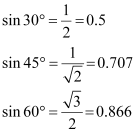
sin 90° = 1
Hence, the given statement is true.
(iii) cos 0° = 1
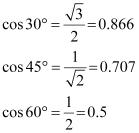
cos90° = 0
It can be observed that the value of cos θ does not increase in the interval of 0° < θ < 90°.
Hence, the given statement is false.
(iv) sin θ = cos θ for all values of θ.
This is true when θ = 45°
As![]()
![]()
It is not true for all other values of θ.
As![]() and
and![]() ,
,
Hence, the given statement is false.
(v) cot A is not defined for A = 0°
As![]() ,
,
![]() = undefined
= undefined
Hence, the given statement is true.
Exercise 8.3 : Solutions of Questions on Page Number : 189
Q1 : Evaluate
(I)![]()
(II)![]()
(III) cos 48° – sin 42°
(IV) cosec 31° – sec 59°
Answer :
(I)![]()
![]()
(II)![]()
![]()
(III)cos 48° – sin 42° = cos (90° – 42°) – sin 42°
= sin 42° – sin 42°
= 0
(IV) cosec 31° – sec 59° = cosec (90° – 59°) – sec 59°
= sec 59° – sec 59°
= 0
Q2 : Show that
(I) tan 48° tan 23° tan 42° tan 67° = 1
(II)cos 38° cos 52° – sin 38° sin 52° = 0
Answer :
(I) tan 48° tan 23° tan 42° tan 67°
= tan (90° – 42°) tan (90° – 67°) tan 42° tan 67°
= cot 42° cot 67° tan 42° tan 67°
= (cot 42° tan 42°) (cot 67° tan 67°)
= (1) (1)
= 1
(II) cos 38° cos 52° – sin 38° sin 52°
= cos (90° – 52°) cos (90°-38°) – sin 38° sin 52°
= sin 52° sin 38° – sin 38° sin 52°
= 0
Q3 : If tan 2A = cot (A- 18°), where 2A is an acute angle, find the value of A.
Answer :
Given that,
tan 2A = cot (A- 18°)
cot (90° – 2A) = cot (A -18°)
90° – 2A = A- 18°
108° = 3A
A = 36°
Q4 : If tan A = cot B, prove that A + B = 90°
Answer :
Given that,
tan A = cot B
tan A = tan (90° – B)
A = 90° – B
A + B = 90°
Q5 : If sec 4A = cosec (A- 20°), where 4A is an acute angle, find the value of A.
Answer :
Given that,
sec 4A = cosec (A – 20°)
cosec (90° – 4A) = cosec (A – 20°)
90° – 4A= A- 20°
110° = 5A
A = 22°
Q6 : If A, Band C are interior angles of a triangle ABC then show that
![]()
Answer :
We know that for a triangle ABC,
∠ A + ∠B + ∠C = 180°
∠B + ∠C= 180° – ∠A

Q7 : Express sin 67° + cos 75° in terms of trigonometric ratios of angles between 0° and 45°.
Answer :
sin 67° + cos 75°
= sin (90° – 23°) + cos (90° – 15°)
= cos 23° + sin 15°
Exercise 8.4 : Solutions of Questions on Page Number : 193
Q1 : Express the trigonometric ratios sin A, sec A and tan A in terms of cot A.
Answer :
We know that,
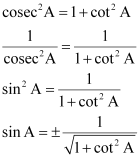
![]() will always be positive as we are adding two positive quantities.
will always be positive as we are adding two positive quantities.
Therefore,![]()
We know that,![]()
However,![]()
Therefore,![]()
Also,![]()

![]()
Q2 : Write all the other trigonometric ratios of ∠ A in terms of sec A.
Answer :
We know that,
![]()
Also, sin2 A + cos2 A = 1
sin2 A = 1 – cos2 A
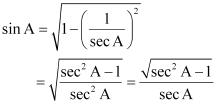
tan2A + 1 = sec2A
tan2A = sec2A – 1
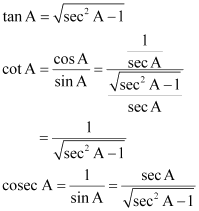
Q3 : Evaluate
(i)![]()
(ii) sin25° cos65° + cos25° sin65°
Answer :
(i)![]()

![]()
(As sin2A + cos2A = 1)
= 1
(ii) sin25° cos65° + cos25° sin65°

= sin225° + cos225°
= 1 (As sin2A + cos2A = 1)
Q4 : Choose the correct option. Justify your choice.
(i) 9 sec2 A – 9 tan2 A =
(A) 1
(B) 9
(C) 8
(D) 0
(ii) (1 + tan θ + sec θ) (1 + cot θ – cosec θ)
(A) 0
(B) 1
(C) 2
(D) – 1
(iii) (secA + tanA) (1 – sinA) =
(A) secA
(B) sinA
(C) cosecA
(D) cosA
(iv)![]()
(A) sec2 A
(B) – 1
(C) cot2 A
(D) tan2 A
Answer :
(i) 9 sec2A – 9 tan2A
= 9 (sec2A – tan2A)
= 9 (1) [As sec2 A – tan2 A = 1]
= 9
Hence, alternative (B) is correct.
(ii)
(1 + tan θ + sec θ) (1 + cot θ – cosec θ)
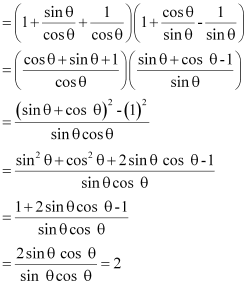
Hence, alternative (C) is correct.
(iii) (secA + tanA) (1 – sinA)
= cosA

Hence, alternative (D) is correct.
(iv)
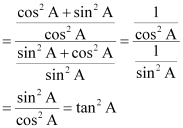
Hence, alternative (D) is correct.
Q5 : Prove the following identities, where the angles involved are acute angles for which the expressions are defined.
Answer :
(i)![]()

(ii)![]()
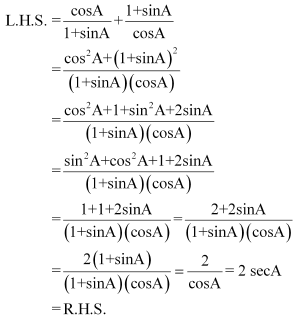
(iii)![]()
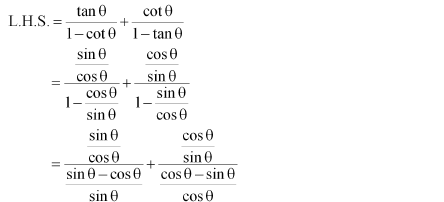
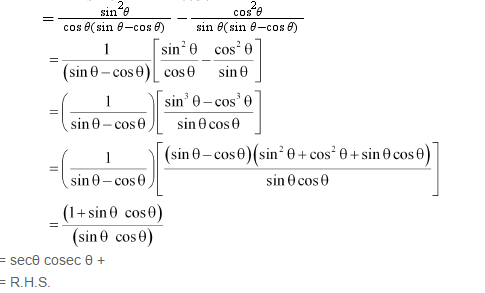



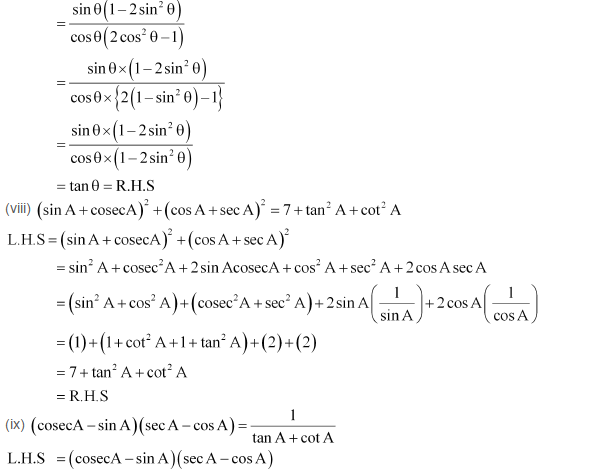

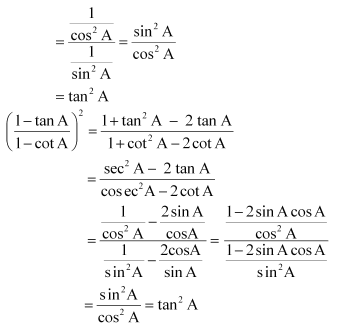
NCERT Solutions for Class 10 Maths All Chapters
- Chapter 1 – Real Numbers
- Chapter 2 – Polynomials
- Chapter 3 – Pair of Linear Equations in Two Variables
- Chapter 4 – Quadratic Equations
- Chapter 5 – Arithmetic Progressions
- Chapter 6 – Triangles
- Chapter 7 – Coordinate Geometry
- Chapter 8 – Introduction to Trigonometry
- Chapter 9 – Some Applications of Trigonometry
- Chapter 10 – Circles
- Chapter 11 – Constructions
- Chapter 12 – Areas Related to Circles
- Chapter 13 – Surface Areas and Volumes
- Chapter 14 – Statistics
- Chapter 15 – Probability